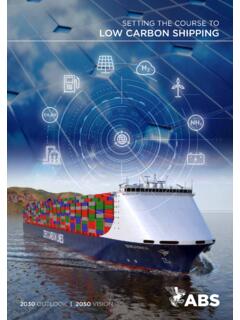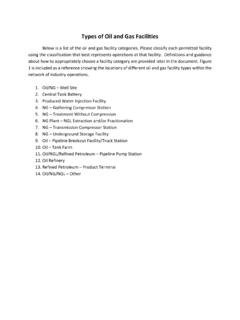Transcription of CARBON CAPTURE, UTILIZATION AND STORAGE
1 CARBON CAPTURE, UTILIZATION . AND STORAGE . AUGUST 2021. SOMKIET POOMSIRIPAIBOON/Shutterstock TABLE OF CONTENTS. OVERVIEW .. 1. Current Developments .. 2. CARBON REDUCTION TECHNOLOGIES .. 4. CARBON Capture From Exhaust Gas .. 5. Combustion Technologies .. 7. CARBON STORAGE AND TRANSPORTATION .. 8. CO2 Conditioning .. 8. CO2 Transportation .. 11. UTILIZATION .. 13. Reuse Options .. 13. PERMANENT STORAGE .. 14. Injection To Wells .. 14. Mineral Carbonation .. 15. REGULATORY ASPECTS .. 16. International Maritime Organization (IMO) .. 16.
2 International Organization For Standardization (ISO) .. 16. Domestic Regulations .. 16. ABS SUPPORT .. 17. REFERENCES .. 18. LIST OF ACRONYMS AND ABBREVIATIONS.. 21. CARBON CAPTURE, UTILIZATION AND STORAGE . OVERVIEW. Climate change is a serious issue and projected greenhouse gas (GHG) emissions present a serious concern for the environment in the near future. The Paris Agreement, adopted by the United Nations Framework Convention on Climate Change (UNFCCC) in 2015 by 196 international Parties, aims to limit global warming to well below 2 C, preferably limited to a safer C, above pre-industrial1 levels.
3 To achieve this ambitious target, a global effort to stabilize and sharply reduce GHG emissions has been initiated. The Intergovernmental Panel on Climate Change (IPCC) presented four scenarios for limiting global temperature rise to C in their Special Report issued in 2019. All the scenarios included CARBON capture and three required the involvement of major use of CARBON capture. Thus, CARBON Capture and STORAGE (CCS) projects have recently gained renewed momentum for expanding development. In this context, the main CARBON substance of concern is CARBON dioxide (CO2), produced as a byproduct of combustion.
4 The International Energy Agency (IEA) introduced the Sustainable Development Scenario2 , denoting a decline in global CO2 emissions from the energy sector to net zero by 2070, inspired by the United Nations (UN) energy-related sustainable development goals for emissions, energy access and air quality. The report explicitly states that reaching net zero will be virtually impossible without CCS, and the CO2 capturing capacity would potentially go up to around 5,635 megatonnes (Mt) in 2050, compared to current annual CO2 capturing capacity at approximately 40 Mt.
5 IEA projects up to 90 percent of emissions from iron and steel, cement, chemicals, fuel transformation and power generation sectors could be potentially reduced through CARBON Capture, UTILIZATION and STORAGE (CCUS) by 2070. Currently, the annual global consumption for CO2 is around 230 Mt, mostly supplying the fertilizer industry that consumes 125 Mt per year, followed by the oil and gas industries, which consume around 70 to 80 Mt per year for Enhanced Oil Recovery (EOR). Clearly, the market demand for CO2 in the foreseeable decades might not meet the increased captured capacity, so the energy industry is investigating ways to expand the options for CO2 UTILIZATION and permanent STORAGE .
6 Injecting CO2 into offshore depleted reservoirs has gained increasing interest. CO2 transport for onshore and especially offshore use or STORAGE will continue to play a critical role for global CO2 mitigation. Olivier Le Moal/Shutterstock 1. Pre-industrial: The multi-century period prior to the onset of large-scale industrial activity around 1750. The reference period 1850 1900 is used to approximate pre-industrial global mean surface temperature. 2. The IEA's Sustainable Development Scenario (SDS) outlines a major transformation of the global energy system, showing how the world can change course to deliver on the three main energy-related SDGs simultaneously.
7 Page 1. CARBON CAPTURE, UTILIZATION AND STORAGE . There are also compelling commercial demands for reducing CO2 emissions for shipping industries to consider. Climate impact is now a measure that influences financing for shipping companies. A global framework was established in 2017 to assess and disclose the climate alignment of financial institutions' shipping portfolios. The Poseidon Principles apply to lenders, relevant leasers, and financial guarantors including export credit agencies. Currently, the signatories to the Poseidon Principles represent nearly 50 percent of the global ship finance portfolio at approximately $185 billion.
8 Other financial trends also showed that the capital has moved toward lower emission asset classes which is showcased by the recent popularity of environment social governance (ESG) investment and the increase in so-called green bonds designed specifically to support climate-related or environmental projects. CURRENT DEVELOPMENTS. CARBON Capture, UTILIZATION , and STORAGE (CCUS) (Figure 1) outlines the process by which CO2 can be captured, cleaned, dehydrated, liquefied, transported, and stored or utilized at a final location. CAPTURE USE.
9 Capturing CO2 from fossil- Using captured CO2 as an or biomass-fueled power input or feedstock to create stations, industrial facilities products or services. or directly from the air. TRANSPORT STORAGE . Moving compressed CO2 Permanently storing by pipeline or ship from CO2 in underground the point of capture to the geological formations, point of use or STORAGE . onshore or offshore. Figure 1 Illustration for CCUS shipping chain According to the Global Status of CCS 2020 Report published by the Global CCS Institute, there are 65 commercial CARBON Capture and STORAGE facilities worldwide with 26 facilities currently in operation3; in total these facilities can capture and store approximately 40 Mt of CO2 per year.
10 Although the overall operational CO2 capture capacity has steadily grown since 2010, the level of activity in CARBON capture dwindled after 2011. However, along with the 2015. Paris Agreement, many governments established stronger climate policies and stakeholders exerted more pressures at private sectors for the ambitious GHG reduction targets, which increased the confidence of CCUS to play an integral role in achieving the targets. Since 2017, more than 30 new integrated facilities were announced. Consequently, the total global CO2 capture capacity would increase to approximately 130 Mt per year, if all the projects announced are fully operational.







